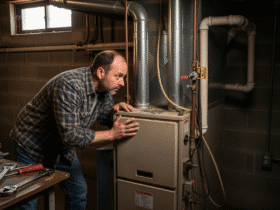If you have clicked on this short article after that, you most likely currently know what a sump pump is; however, if you do not know or if you’re confused concerning its features, then permit us to acquaint you with sump pumps. A sump pump is a pump that can help you maintain your basement completely dry if your cellar has wetness. Let’s take a look at the method of Installing a Sump Pump.
Sump pumps are set up where water obtains accumulated, and generally, it is the basement of your home. What they do is they gather the water and after that pump it out of the house. The cellars are the structure of your home. If the house’s foundation is swamped after that, imagine what would certainly happen to your house. Setting up a sump pump can be like a financial investment that will certainly conserve you from future catastrophes. So, go ahead and read more.
Things Needed For Installing a Sump Pump
Materials
- Corrugated pipe
- Submersible sump pump
- Filter fabric
- Pressurized fittings
- Wire ties
- Cement
- PVC pipe
- Wire ties
- Flexible Discharge hose
- Increaser
- Gravel
- Float valve
- Hole saw bit
- J hooks
- Fittings
- Silicone sealant
Tools
- Sledgehammer
- Drill bit
- Electric drill
- Pipe Cutter
Steps For Installing a Sump Pump
Step 1: Find Location
Determine the point where you generally initially see water collecting. Typically, this is the lowest factor in the basement. After that, ensure this place is near a GFCI (Ground Mistake Interrupter Outlet) so that it can plug in the sump pump here. If you do not have a plugin near this area, then don’t fret. A certified electrical contractor can set up one.
Step 2: Dig in
Dig a hole in the chosen area, and also, the hole should be about 10 inches wide and six inches deep to fit in the sump pump.
The trouble arises when your cellar has a concrete floor. Digging it will be a job for you. However, you can either lease a sledge or a jackhammer for this.
Step 3: Preparing the Ground
The most practical sump pumps usually have to weep holes in them, which permit water to go into from the sides and beneath, even when switched off. If your own has these openings currently, after that well and good; however, if it does not, then don’t wait from drilling them yourself. To make this opening into the discharge pipeline, utilize a 1/4 inch drill and make sure the hole is six-inch above the pump.
Next, stand in the sump and add two or three inches of gravel to the bottom of the hole. Position some pebbles on the flooring of the dig to ensure that the sump pump can have a stable platform to sit on.
Step 4: Drift Shutoff
Examine if the float valve is operating or otherwise before going better. It should openly move down and up. Whenever the water level in the basement indeed climbs, the float shutoff will rise as well, and the sump will undoubtedly turn on to do its task. Use your hands to move it slowly to inspect if it is running.
Step 5: Inspect Valve
Currently is the time for the check shutoff. It channels the water from the sump to the outside of your house. A flexible discharge hose or a PVC pipeline (with joints) will certainly run between the shutoff and outside the home. Make sure you examine that the check shutoff is for proper procedure as well as not simply straight.
Make a big hole from where the outcome will head out of your home. You can utilize a releasing hose or PVC pipe for this. Whatever you make use of need to fit in that opening. As soon as the pipe is suited to this opening, use a silicone sealer to load any gaps. The PVC pipeline you’re using here must be 11/2 inches.
Step 6: Trial Run
When you have done all the labour of Installing a Sump Pump, it’s time for a dry run to check if everything works appropriately or otherwise. Lots the basin with water practically to the leading, and if the float is operating efficiently, it ought to climb. The pump should begin working as well as the water ought to be out, leaving your cellar completely dry.
Area the cover over the container and examine if there are any sort of leakages in the whole system.
Step 7: Concrete it
The last action should certainly be to cover the hole bordering the pump with concrete. You will not need a lot of it anyhow, so make a little set with a thick consistency afterwards declared to conceal every little thing other than the lid of the sump pump.
Phew! You’re done Installing a Sump Pump. You don’t need to obtain all fretted the list below time if there’s any wetness in the basement.










